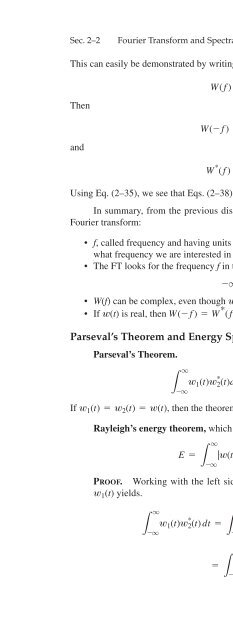563489578934
Sec. 2–2 Fourier Transform and Spectra 49 This can easily be demonstrated by writing the spectrum in polar form: Then and W(f) = |W(f)|e ju(f) W(-f) = |W(-f)|e ju(-f) W * (f) = |W(f)|e -ju(f) Using Eq. (2–35), we see that Eqs. (2–38) and (2–39) are true. In summary, from the previous discussion, the following are some properties of the Fourier transform: • f, called frequency and having units of hertz, is just a parameter of the FT that specifies what frequency we are interested in looking for in the waveform w(t). • The FT looks for the frequency f in the w(t) over all time, that is, over -q 6 t 6q • W(f) can be complex, even though w(t) is real. • If w(t) is real, then W(-f) = W * (f). Parseval’s Theorem and Energy Spectral Density Parseval’s Theorem. L If w 1 (t) = w 2 (t) = w(t), then the theorem reduces to q -q q w 1 (t)w * 2 (t)dt = W 1 (f)W * 2 (f)df L -q (2–40) Rayleigh’s energy theorem, which is q q E = |w(t)| 2 dt = |W(f)| 2 df L L (2–41) PROOF. Working with the left side of Eq. (2–40) and using Eq. (2–30) to replace w 1 (t) yields. L q -q -q q q w 1 (t)w * 2 (t) dt = c W 1 (f)e j2pft df dw * 2 (t) dt L L -q = L q -q q -q L-q -q W 1 (f)w 2 * (t)e j2pft df dt
- Page 94: Sec. 1-11 Coding 23 Convolutional C
- Page 98: Sec. 1-11 Coding 25 0 1 0 (00) Path
- Page 102: Sec. 1-11 Coding 27 10 -1 P e = Pro
- Page 106: Sec. 1-11 Coding 29 TABLE 1-4 CODIN
- Page 110: Problems 31 Solution: Using Eq. (1-
- Page 114: Problems 33 1-17 Using the definiti
- Page 118: Sec. 2-1 Properties of Signals and
- Page 122: Sec. 2-1 Properties of Signals and
- Page 126: Sec. 2-1 Properties of Signals and
- Page 130: Sec. 2-1 Properties of Signals and
- Page 134: Sec. 2-1 Properties of Signals and
- Page 138: Sec. 2-2 Fourier Transform and Spec
- Page 142: Sec. 2-2 Fourier Transform and Spec
- Page 148: 50 Signals and Spectra Chap. 2 Inte
- Page 152: 52 Signals and Spectra Chap. 2 TABL
- Page 156: 54 Signals and Spectra Chap. 2 Exam
- Page 160: 56 Signals and Spectra Chap. 2 DEFI
- Page 164: ( ( 58 Signals and Spectra Chap. 2
- Page 168: 60 Signals and Spectra Chap. 2 Usin
- Page 172: 62 Signals and Spectra Chap. 2 t w
- Page 176: 64 Signals and Spectra Chap. 2 TABL
- Page 180: 66 Signals and Spectra Chap. 2 wher
- Page 184: 68 Signals and Spectra Chap. 2 Orth
- Page 188: 70 Signals and Spectra Chap. 2 obta
- Page 192: 72 Signals and Spectra Chap. 2 2. I
Sec. 2–2 Fourier Transform and Spectra 49<br />
This can easily be demonstrated by writing the spectrum in polar form:<br />
Then<br />
and<br />
W(f) = |W(f)|e ju(f)<br />
W(-f) = |W(-f)|e ju(-f)<br />
W * (f) = |W(f)|e -ju(f)<br />
Using Eq. (2–35), we see that Eqs. (2–38) and (2–39) are true.<br />
In summary, from the previous discussion, the following are some properties of the<br />
Fourier transform:<br />
• f, called frequency and having units of hertz, is just a parameter of the FT that specifies<br />
what frequency we are interested in looking for in the waveform w(t).<br />
• The FT looks for the frequency f in the w(t) over all time, that is, over<br />
-q 6 t 6q<br />
• W(f) can be complex, even though w(t) is real.<br />
• If w(t) is real, then W(-f) = W * (f).<br />
Parseval’s Theorem and Energy Spectral Density<br />
Parseval’s Theorem.<br />
L<br />
If w 1 (t) = w 2 (t) = w(t), then the theorem reduces to<br />
q<br />
-q<br />
q<br />
w 1 (t)w * 2 (t)dt = W 1 (f)W * 2 (f)df<br />
L<br />
-q<br />
(2–40)<br />
Rayleigh’s energy theorem, which is<br />
q<br />
q<br />
E = |w(t)| 2 dt = |W(f)| 2 df<br />
L L<br />
(2–41)<br />
PROOF. Working with the left side of Eq. (2–40) and using Eq. (2–30) to replace<br />
w 1 (t) yields.<br />
L<br />
q<br />
-q<br />
-q<br />
q q<br />
w 1 (t)w * 2 (t) dt = c W 1 (f)e j2pft df dw * 2 (t) dt<br />
L L<br />
-q<br />
=<br />
L<br />
q<br />
-q<br />
q<br />
-q L-q<br />
-q<br />
W 1 (f)w 2 * (t)e j2pft df dt



